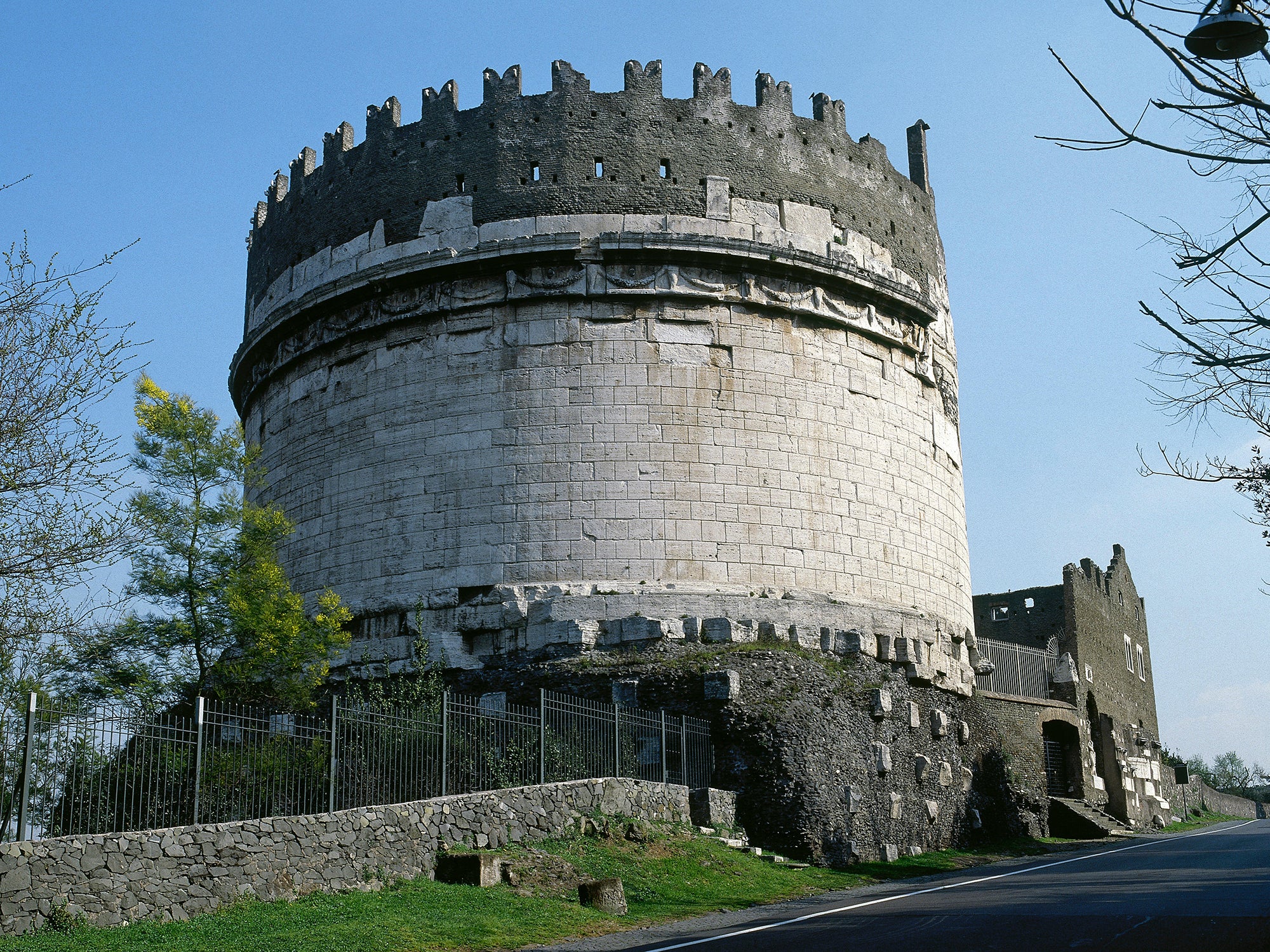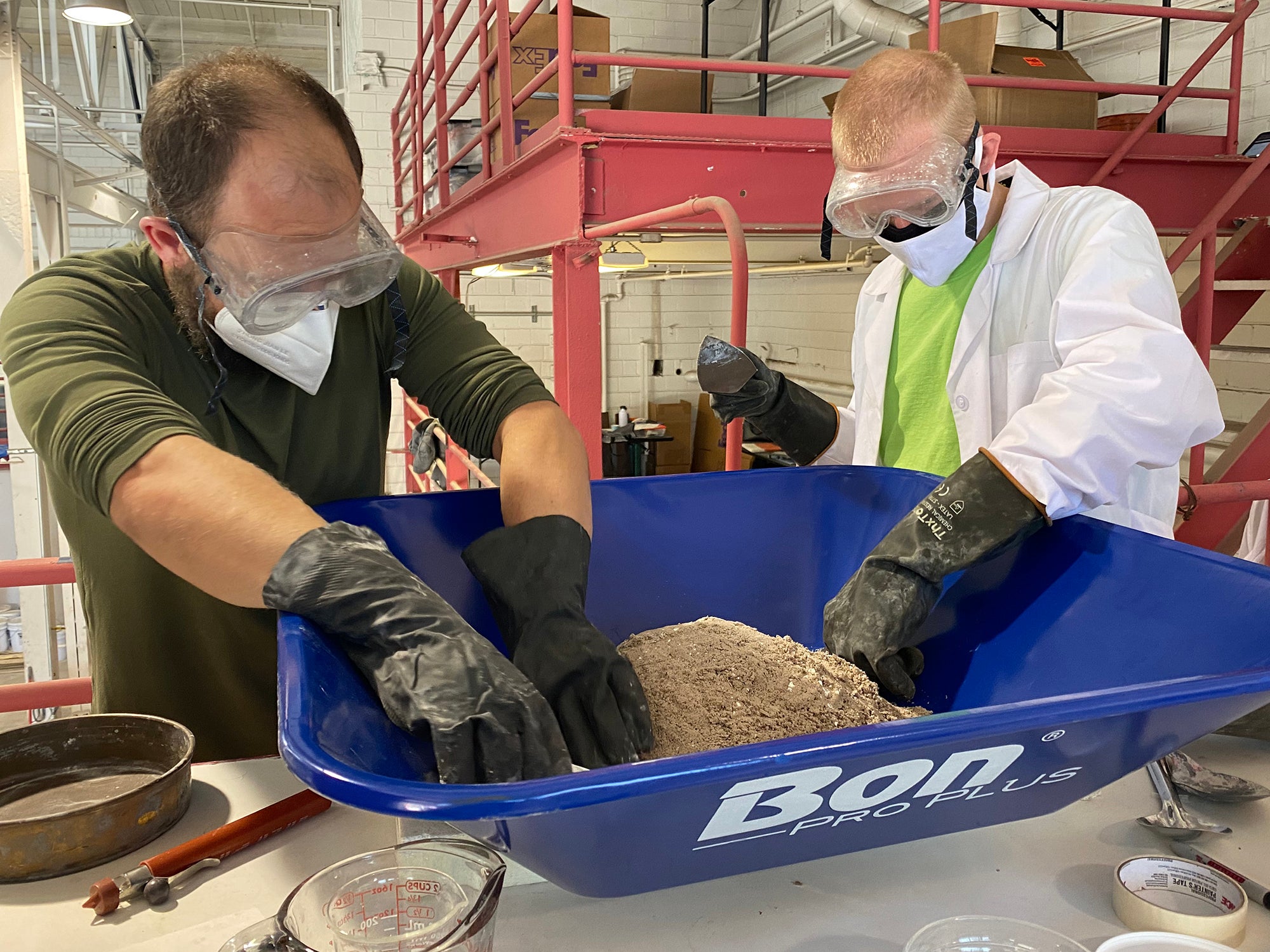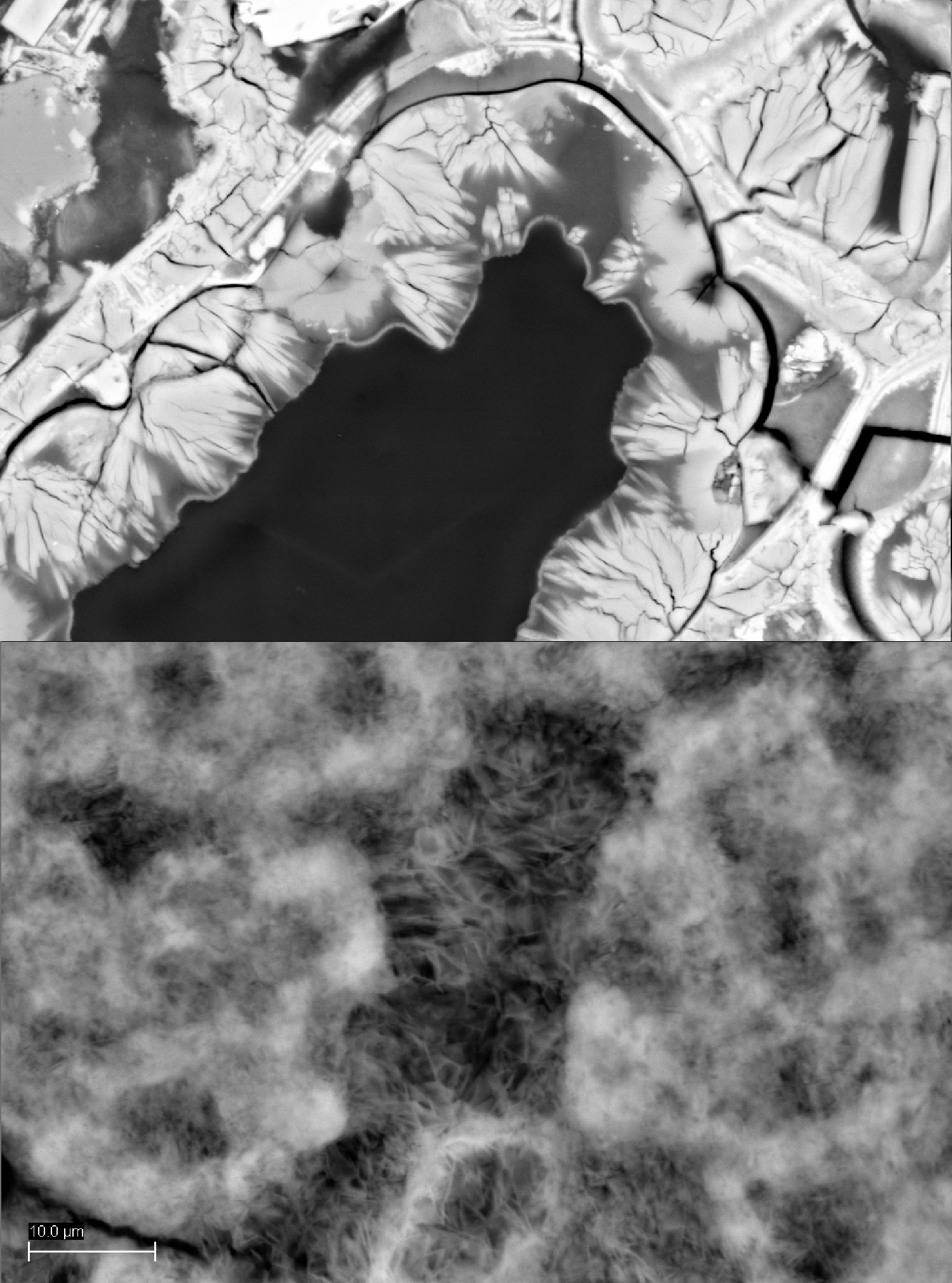ANCIENT ROMANS were masters of concrete, fashioning concoctions of sand, water, and rock into long-lasting marvels. Bridges, stadiums, and other structures they built with the stuff still stand tall—even harbors and breakwaters that have been soaked by tides and storms for nearly 2,000 years. This substance, robust to the microscopic level, far outlives the modern material, which generally requires steel supports in salt water and is still likely to corrode within decades.
When the Roman Empire ended, so did its method of making marine concrete. But by following chemical clues within ancient architecture, today’s scientists have revived this technique. In recent years, researchers have only gotten better at understanding it, applying lessons from fields as diverse as archaeology, civil engineering, and volcanology. They have pulled tubes of the ancient substance from under the ocean. They have zapped it with X-rays to observe its microscopic minerals. Now they’ve mixed up their own industrial version.
In 2023, for the first time in nearly two millennia, Roman-style marine concrete will be tested on a coastline. Silica-X, a US-based company that specializes in experimental glass, plans to place four or five slabs into Long Island Sound beginning this summer. Unlike virtually all other concrete products made today, which are designed to resist their environments, these 2,600-pound samples will embrace their aquatic surroundings—and are expected to become stronger over time.
As water moves through the porous solid, the material’s minerals will dissolve, and new, strengthening compounds will form. “That is actually the secret of Roman concrete,” says University of Utah geology and geophysics research associate professor Marie D. Jackson, who is working on a reboot of the stuff with a $1.4 million grant from the Advanced Research Projects Agency–Energy, a federal program that supports early-stage technology research.

Jackson has spent more than a decade investigating what happens when Roman concrete meets seawater. She is part of a team working alongside Silica-X; the prototypes destined to be dunked in the New York estuary are based on her recipe.
“One hundred percent, Marie is the most significant person” trying to understand and develop the substance, says her frequent collaborator, Google hardware developer Philip Brune. More than a decade ago, when Brune was a Ph.D. student, he and Jackson created the first of what they call Roman concrete analogues. After making a terrestrial type—similar to the basis of the Pantheon and Trajan’s Market—they switched to a marine variant.
Jackson has an application in mind for these historical replicants: guarding against the effects of climate change. The National Oceanic and Atmospheric Administration projects that by 2050, sea levels will rise by an average of 10 to 12 inches along American coasts. Modern concrete sea walls, which need to be replaced roughly every 30 years, already cover a substantial percentage of the US shoreline. If waves keep mounting, it will be necessary to find a more durable and sustainable option to reinforce our seaboards.
The duality of concrete
Concrete’s ingredients are about as simple as a sugar cookie’s. Besides water and air, it requires a grainy material called aggregate, which may be sand, gravel, or crushed rock. The other necessity is cement, a mineral glue that holds the constituents together. Portland cement, invented in the mid-1800s in England, remains the basis for the majority of modern concrete formulas. This mix results in a consistently potent product. “You can make it on Mars with the same ingredients, and you know it will work,” says Admir Masic, associate professor of civil and environmental engineering and principal investigator at the Massachusetts Institute of Technology’s Concrete Sustainability Hub.
Portland cement production is the noxious part: Not only is it thirsty for fresh water and energy, it also releases loads of carbon dioxide. The manufacturing process is responsible for 7 to 8 percent of worldwide CO2 emissions, according to Sabbie Miller, a civil and environmental engineering assistant professor at the University of California, Davis. If the global concrete industry were a nation, its greenhouse gas footprint would be the third biggest on the planet, after those of China and the US.
The concrete sector is aware of its product’s environmental legacy and is willing to work toward change, Miller says. Global construction conglomerate HeidelbergCement, for one, announced in 2021 that it would construct the first carbon-neutral cement plant by 2030, a facility that would capture greenhouse gases and lock them up in bedrock below the sea. Other types of concrete in development are designed to lock up pollution within the material itself. Miller, who is working on techniques to turn carbon into a solid, storable mineral, says these are “very much early-days, we’ll-see-if-it-works technologies.”



Making concrete as the Romans did should reduce troublesome emissions, researchers say, in large part because this substance won’t need to be replaced frequently. Yet the ancient process doesn’t yield quite as much compressive strength—this resource won’t hold up super-tall buildings or heavily traveled bridges. In the concrete heart of Manhattan, “We will not use Roman-inspired material,” says Masic, who co-authored a paper with Jackson and two others on reactions within the building materials in the Roman tomb of Caecilia Metella and is an inventor of what he calls a “self-healing” substance. Rather, he says, the timeless concoction could be fashioned into roads that resist wear, walls that withstand waves, and vaults that confine nuclear waste.
What Roman-style concrete does best is survive, aided by its ability to repair itself within days. “This material has phenomenal durability,” Brune says. “Nothing else that you find in the built environment lasts with as much integrity and fidelity.” A key ingredient that gives it this ability lies in the sand-like pozzolan of Pozzuoli, Italy.

From fire to the sea
Jackson did not set out to unlock the secrets of Roman concrete. Drawn to volcanology and rock mechanics, she studied Hawaii’s Mauna Loa in the late ‘80s and early ‘90s. In 1995, she spent a year in Rome with her family, living near the ruins of the Circus Maximus, once a huge chariot-racing stadium. While there, she became fascinated with the volcanic rock incorporated into the city’s celebrated classical architecture.
Roman concrete has been the subject of intense scholarship—structures that persist for thousands of years tend to attract attention. But Jackson, with her geologist’s eye, saw something powerful below the surface. “It is very difficult to understand this material unless one understands volcanic rocks,” she says. In her analysis, Jackson focused on tephra, particles spit out in a volcanic eruption, and tuff, the rock that forms when tephra firms up.
Her first paper about Roman building materials, a collaboration with four other scientists, was published in the journal Archaeometry in 2005. The group described seven deposits where ancient builders had collected tuff and stones. These were products of explosive eruptions from two volcanoes north and south of Rome. By the first century BCE, Roman architects had recognized the resilience of these rocks and had begun to place them in what Jackson notes were “strategic positions” around the city.
While she examined materials in the Eternal City, others were separately scouring the sea. A trio of scholars and scuba divers—classical archaeologists Robert L. Hohlfelder and John Oleson, and London-based architect Christopher Brandon—launched the Roman Maritime Concrete Study in 2001. Over the next several years, they collected dozens of core samples from Egypt, Greece, Italy, Israel, and Turkey, taken from 10 Roman harbor sites and one piscina, a seaside tank for corralling edible fish.
Some of the locations they inspected were immense structures: At Caesarea Palaestinae, a port city built between 22 and 10 BCE during the reign of King Herod, Romans created a harbor from an estimated 20,000 metric tons of volcanic ash.
To look inside the ruins, the archaeologists needed heavy machinery. “You used to whack some pieces off the outside of a big, maybe 400-cubic-meter lump of concrete on the ocean floor,” says Oleson, a University of Victoria professor emeritus. But that approach has flaws. The surface is already decayed from sea growth, so whatever breaks off might not represent what’s deeper inside. “You’ve also been whacking on it with a hammer,” he says, which can foul the opportunity to measure its material strength.

The project required a more precise, piercing touch. A cement company in Italy, Italcementi, provided funding and helped get the three men a specialized hydraulic coring rig. Diving beneath the Mediterranean, they spent hours drilling, extracting cylindrical cores up to 20 feet long. “It was difficult,” Oleson says. “In places like Alexandria, the visibility—because of all the things you don’t want to think about—was less than your arm length.”
That effort paid off. No one had been able to look at the layers within the submerged structures before. The opinion at the time was that the concrete must have been extra strong to last for thousands of years in seawater. But that wasn’t the case, Oleson and his colleagues found: “In modern engineering terms, it’s quite weak,” he says. What it was, though, was remarkably consistent in its volcanic elements. Oleson theorizes that grain ships used Neapolitan pozzolan as ballast, ferrying it to work sites hundreds of miles from its source.
In 2007, the trio’s presentation on seawater concrete won an award at the Archaeological Institute of America’s annual meeting. “I was standing there, bathing in the glory, and this short, excitable woman came up and started talking to me,” Oleson recalls. The stranger was Jackson, who Oleson says launched into a detailed explanation of the rare crystal minerals she had observed within Roman architectural concrete. Oleson, for his part, had never taken a college chemistry course, but he recognized a kindred spirit—and that this geologist had expertise his group needed.
They gave Jackson access to the maritime samples. And when she peered inside, she found chemical laboratories on a nanometer scale.
Reactions in the rock
In his first-century work Natural History, Roman author Pliny the Elder wrote of a dust that “as soon as it comes into contact with the waves of the sea and is submerged, becomes a single stone mass, impregnable to the waves and every day stronger.” How precisely these wet grains—the pozzolan—became ever stronger would not be revealed for almost 2,000 years.
When Jackson investigated the core samples Oleson and his colleagues had obtained, she spotted some of the same features she’d seen in the architectural concrete in metropolitan Rome. But in the sunken stuff, she also saw what she labeled mineral cycling: a looping reaction in which compounds formed, dissolved, and formed new ones.
To make concrete, Romans mixed tephra with hydrated lime. That accelerates the production of a mineral glue called calcium aluminum silicate hydrate, or C-A-S-H. (The backbone of unadulterated modern concrete, C-S-H, is a similar binder.) This happens within the first months of installation, Jackson says. Within five to 10 years, the material composition changes again, consuming all the hydrated lime through a kind of microscopic interior remodeling. By then, percolating fluid “begins to really make a difference” as it produces long-lasting, cementlike minerals within.

Jackson and a team of scientists used sophisticated microscope and X-ray techniques, including work done at the Lawrence Berkeley National Laboratory’s Advanced Light Source, to look at these powerful but teeny crystals. “We were able to show systematically that Roman seawater concrete had continued to change over time,” she says. Within each pore of the concrete, seawater had reacted with glass or crystal compounds. In particular, she found stiff, riblike plates of a rare mineral known as aluminous tobermorite, which probably help prevent fractures, as she and her colleagues wrote in a 2017 paper in the journal American Mineralogist.
The ocean itself plays a vital role. Roman fabricators made their marine concrete mixtures with seawater, and its salts became part of the mineral structure—sodium, chlorine, and other ions helped activate the tephra-lime reaction. Once the concrete was in the tides, as fluid slowly percolated through the hulking edifices, life flourished on the facades. Worms made tubes and other invertebrates sprouted shells.
Modern reinforced concrete, meanwhile, needs a high pH to preserve the steel rebar within, which means its surface is less friendly to living things. Once it is cast, after about 28 days of hardening and curing, it is near its maximum sturdiness, Brune notes. (Attempts are underway to give newer kinds of concrete the ability to restore themselves, such as infusing the material with bacterial spores that create limestone.)
“We were able to show systematically that Roman seawater concrete had continued to change over time.”
—Marie D. Jackson
Specifically, concrete using Portland cement is as brittle as it is strong. Under too much strain, it cracks, sometimes with a sharp snap that propagates and causes wide-scale failure. “The ability of the material to carry further loads, it’s gone. It’s fractured,” Jackson says.
Roman concrete breaks differently. Brune and Jackson have tested their analogues under strain, creating semicircles out of the blend and pressing them to the cracking point. They observed that unlike extremely inflexible substances that will fail and essentially split into halves, Roman concrete displaces the strain over many small fractures, without necessarily losing its overall integrity. “Roman concrete-style materials respond really well to that kind of cracking,” Brune says, adding that this feature could explain why the age-old recipe has endured so long despite earthquakes and the churn of aquatic environments.
White clumps of lime found in Roman concrete can also keep it robust, as Masic and fellow MIT scientists reported in a Science Advances paper in January. In lab experiments, the team drained water through cracked concrete cylinders for 30 days. Water continuously flowed through broken samples of typical concrete. But in concrete with added lime gobs, calcite crystallized to fill the gaps.
Jackson and Brune have observed similar self-restoring abilities in their marine concrete replicas. In to-be-published experiments funded by the Advanced Research Projects Agency-Energy grant, they again cracked semicircles of the concoction. When they placed the damaged arcs in containers of seawater, chemical reactions resumed—new glue accumulated in the fractures. This, Jackson says, is concrete that self-repairs.
New trials, new island
As 2023 surges on, Roman-style concrete will venture further than ever before. US Army Corps of Engineers research geologist Charles Weiss, who studies concrete and other structural materials, has submitted a proposal to try out Jackson’s formula. If the Vicksburg, Mississippi, military lab receives the funds—“Working for the government, nothing is for sure,” he says—Corps researchers will cast the material and place it in a body of water.
Elsewhere, another federal project’s failure may have helped Jackson’s creation along. In the 2010s in South Carolina, at the Department of Energy’s Savannah River National Laboratory, scientists were trying to make a product that could safely store radioactive garbage.

The national lab wanted to create foam glass, a type of bubble-filled substance meant to be inactive, and contracted the Silica-X team to help. They weren’t successful. The mixture kept reacting with its surroundings—a problem because if radioactive waste receptacles dissolve, they can release unstable particles. But what’s bad for nuclear trash is good for sea walls designed to respond to their environs. Glass designers at the lab recognized this potential and connected Jackson with the company.
Despite the growing interest in Roman-style concrete, it is neither feasible nor sustainable to mine industrial amounts of pozzolan from Naples. Instead, Philip Galland, Silica-X’s chief executive, says its production process digs into nonnuclear US waste streams to obtain silica, which is then transformed into synthetic tephra. That will be the basis for the upcoming Long Island Sound field test, Galland says, in an “area where it can offer shoreline resilience.”
Silica-X plans to assess the 3.5-foot cubes’ durability over two years. Along with its partners—the New York Department of Environmental Conservation and Alfred University, home to an influential ceramics college—the company will analyze the material’s potential as a storm surge barrier and how it performs as a habitat for microbes and other local marine life.
At the same time, Jackson has returned to her original subject matter: volcanoes. She is the principal investigator of a project to study Surtsey, a tiny volcanic island off of Iceland that’s just 60 years old. A UNESCO World Heritage site, it emerged from the Atlantic in sprays of smoke and lava from 1963 to 1967. “I remember when it first erupted,” Jackson says, “because my dad came home from work and told us that there was a baby volcano erupting.”
At Surtsey, scientists have found microbial life in basalt rocks previously untouched by humans. (Aside from research teams who arrive by boat or helicopter, visitors are banned from the volcano.) They have drilled to the seafloor, through stone that is still hot years after the last eruption, and examined the tephra there. As it slumbers, Jackson believes this place can reveal what happened in the early years of submerged Roman concrete.
What she knows about the material has been gleaned from stuff that’s aged for thousands of years underwater. Although the young terrain is an imperfect replica of the coveted ancient ingredient—the fluids there aren’t quite the same as what percolated through the Roman structures—Jackson says she has already spied some similar geochemical processes. The ash and seawater around the volcano offer a parallel to the early reactions that gave a great civilization its building blocks. This is a living laboratory that could teach us Roman concrete’s art of change, witnessed on a scale as massive as a new island or as tiny as minerals morphing across millennia. If all goes well, the modern version of this powerful invention will outlast its makers just the same.
Read more PopSci+ stories.
The post Inside the project to bring ‘self-healing’ Roman concrete to American shorelines appeared first on Popular Science.
Articles may contain affiliate links which enable us to share in the revenue of any purchases made.
from Popular Science https://ift.tt/BxjOcXn






0 Comments